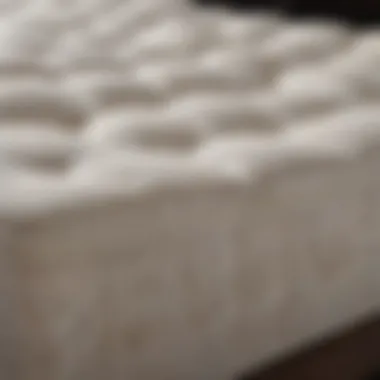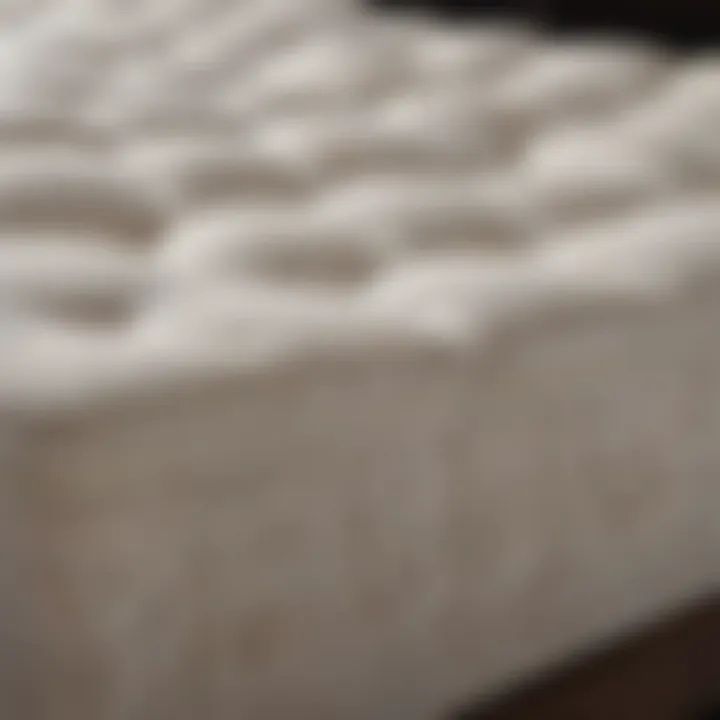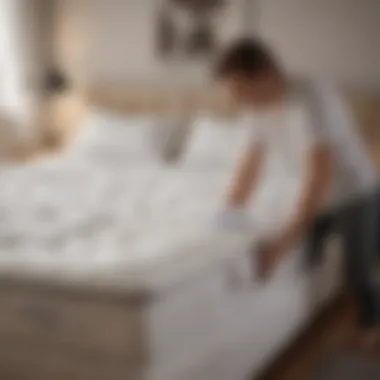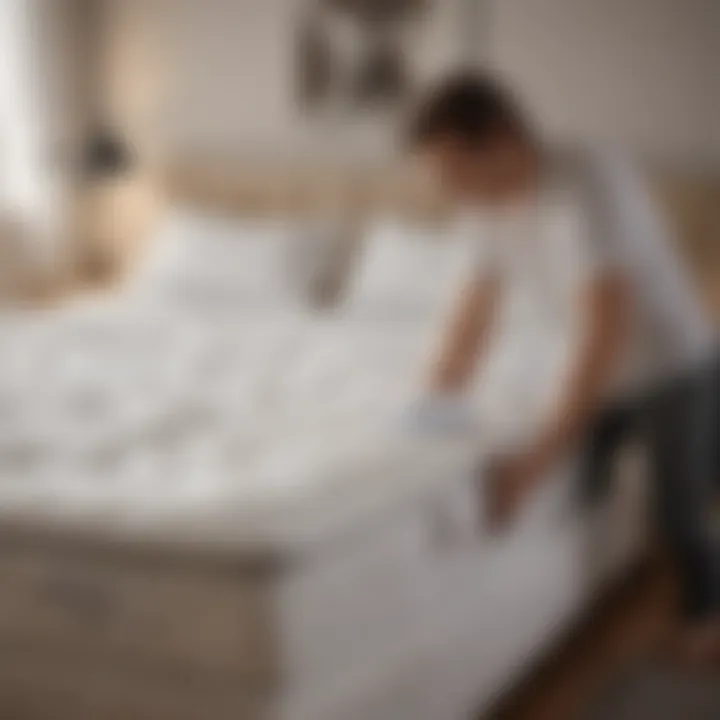Effective Strategies for Cleaning Your Mattress


Intro
A clean bed mattress is more than a pretty piece of furniture. It plays a critical role in ensuring good health and restful sleep. After all, it’s where we spend about a third of our lives. Yet, many homeowners overlook the importance of keeping their mattresses spotless. Dust mites, stains, and odors can accumulate over time, turning your haven into a potential health hazard.
In this article, we dive into practical and effective methods for cleaning a dirty mattress, ensuring you understand not just how to remove stains but also how to regularly maintain it to prolong its lifespan. There’s a lot to cover, from the various types of stains you might encounter to the essential tools you'll need. Plus, we'll touch upon preventive measures so your mattress stays cleaner for longer.
With clear guidance and insights, both homeowners and design enthusiasts can elevate their sleeping environments. Let’s get down to the nitty-gritty and help you create a healthier sleep space.
Design Inspiration
When it comes to maintaining a mattress, the presentability and design of the bed can influence how often you feel compelled to clean it. An attractive bed setup can not only motivate regular maintenance but also create an inviting space for sleep.
Trending Styles
In recent times, minimalism and natural aesthetics have taken the spotlight. Beds adorned with light-colored linens and plush, natural-fiber mattresses—think cotton or linen—are all the rage. This trend not only promotes a serene atmosphere but also emphasizes cleanliness. Selecting a bed frame that is easily approachable for cleaning, like a platform or slatted design, allows for proper air circulation underneath, reducing the risk of unwanted dust and grime accumulating out of sight.
Color Palettes
Utilizing soft, muted tones for your bed linens facilitates an air of freshness, which complements a clean mattress. Consider colors like soft white, pastel blues, or muted greens that convey tranquility. Furthermore, darker color bases can be clever for hiding minor imperfections or stains before a thorough cleaning session is conducted. Opt for quality fabrics that are easy to wash and maintain, further advocating for an ongoing clean aesthetic in your sleep space.
Practical Tips
Cleaning a mattress is no small feat, but breaking down the process can make it manageable. Here are practical tips for maintenance and efficiency in caring for your bedding.
Maintenance & Care
- Regular Vacuuming: At least once a month, grab your vacuum with an upholstery attachment and give your mattress a good suck. This helps eliminate dust, skin flakes, and other allergens that may be lurking.
- Spot Clean Stains: For spills or stains, act fast. Blot (don’t rub!) with a clean cloth and use an appropriate cleaning solution. Solutions like vinegar and water can work wonders for light stains. Don’t forget to dry the area thoroughly afterward.
- Rotate Regularly: Every three to six months, give your mattress a good rotation. This helps it wear evenly and extend its lifespan.
- Use a Mattress Protector: When you invest in a quality mattress, it makes sense to protect your investment. A waterproof mattress protector can deter stains and allergens, while also making cleaning easier.
Budgeting & Planning
Planning an effective cleaning routine doesn’t have to break the bank. Here’s how:
- Budget for Cleaning Supplies: A couple of all-purpose cleaners, baking soda, and a good vacuum are all you need. Allocate around $30-$50 for these essentials.
- Schedule Cleaning Days: Mark your calendar. Whether it’s once a month or with the change of seasons, having dedicated cleaning days makes it less overwhelming.
- DIY Solutions: Before purchasing commercial products, consider DIY options that often work just as well. Vinegar, baking soda, and essential oils serve up effective cleaning solutions while being wallet-friendly.
"Regular care and attention can turn a dirty mattress back into a cozy retreat, which is essential for recharging our bodies."
Preface to Mattress Care
In the realm of home maintenance, mattress care often falls to the wayside. This oversight can carry significant repercussions for health and comfort. A clean mattress is pivotal not just for maintaining hygiene, but also for ensuring a good night's sleep. When one considers the time spent resting, it becomes clear that investing effort into mattress maintenance is an act of self-care that pays dividends in well-being. Regular cleaning prevents the accumulation of allergens, dust mites, and other unwanted guests that can disrupt the peace of sleep.
Importance of a Clean Mattress
It's tempting to think, "Out of sight, out of mind," when it comes to mattresses, but that's a dangerous pitfall. Consider this: a significant portion of your day is spent sleeping, often on a surface that isn't regularly cleaned. Over time, skin cells, sweat, and even small food crumbs can build up. Without proper attention, this debris transforms an inviting sanctuary into a breeding ground for bacteria and allergens. The benefits of a clean mattress go beyond mere aesthetics. Sleep contributes immensely to physical health, mental clarity, and emotional stability. By prioritizing cleanliness, you cultivate an environment conducive to restorative sleep.
Common Mattress Contaminants
You may be wondering, what exactly contaminates my mattress? The answer is not so straightforward, but several culprits stand out:


- Dust Mites: Microscopic creatures that thrive in warm, humid settings. They feast on dead skin and can trigger allergies.
- Bacteria and Fungi: These can find a welcoming habitat in dank conditions, often surfacing due to sweat.
- Stains: Accidental spills, bodily fluids, or remnants from late-night snacks tend to seep into the fabric, offering an unwelcome presence.
- Odors: From pets to humidity, various sources can leave a lasting scent that’s less than desirable.
Understanding these contaminants can inspire proactive steps in keeping your mattress pristine. After all, a clean mattress not only enhances the aesthetic appeal of your bedroom but also plays a critical role in your health.
Understanding Mattress Materials
Understanding the materials that make up a mattress is crucial in the quest for creating a clean and comfortable sleeping environment. Different types of mattresses offer varied levels of support, comfort, and longevity, but they also come with specific cleaning considerations. A deep dive into these materials helps homeowners and interior design enthusiasts make informed choices, as well as maintain and prolong the life of their bedding. This knowledge ensures that cleaning and maintenance are tailored to the unique characteristics of each mattress type, ultimately enhancing the quality of sleep.
Different Types of Mattresses
Mattresses can be broadly categorized into several types, each boasting distinct features that affect their care and upkeep. Here’s a quick rundown:
- Innerspring Mattresses: These utilize coils to provide support, often landscaped with layers of foam or padding for comfort. While breathable, they require regular rotations to prevent sagging.
- Memory Foam Mattresses: Known for their contouring properties, these mattresses respond to body heat and pressure. They can trap heat and moisture, making deep cleaning essential to combat odors.
- Latex Mattresses: Made from natural or synthetic rubber, latex mattresses are durable and resistant to dust mites. However, they may require careful spot cleaning due to their elastic nature and potential for staining.
- Hybrid Mattresses: Combining innerspring with foam or latex, these mattresses aim for the best of both worlds. The variety in materials means cleaning requirements can vary significantly.
- Air Mattresses: These are primarily for temporary use and come with specific challenges. Cleaning involves ensuring no leakage and maintaining the surface fabric, which can accumulate dust.
As you can see, each mattress type comes with its own set of cleaning hurdles. Understanding these distinctions will help establish the right cleaning approach.
Specific Cleaning Needs per Material
Delving deeper into the specific cleaning needs shows just how pivotal it is to know what type of mattress you own. Here are some considerations for each type:
- Innerspring Mattresses: Regular vacuuming along with periodic deep cleaning, especially focusing on the fabric and seams, will help. Be careful with excess moisture, as it can lead to rusting of the coils.
- Memory Foam Mattresses: Spot cleaning is key; avoid soaking them. Instead, use mild detergent mixed with water and a cloth. Baking soda can work wonders for odor removal.
- Latex Mattresses: Gentle cleaning with a damp cloth suffices for most stains. It’s vital to not use harsh chemical cleaners, as they can break down the latex.
- Hybrid Mattresses: Due to combined materials, checking each layer for specific cleaning needs is important. Avoid using steam cleaners as they can compromise the integrity of foams or latex inside.
- Air Mattresses: Keep away from using bristle brushes which can puncture them. Instead, opt for soft cloths and mild detergents to clean surface stains and dust.
Proper knowledge of mattress materials not only leads to effective cleaning but also extends the lifespan, ensuring a worthy investment for a good night’s sleep.
In summary, grasping the differences in mattress types and their respective cleaning requirements puts you one step ahead in maintaining a pristine sleep space. This understanding is not just about aesthetics; it’s a commitment to your health and comfort that pays off in the long run.
Tools Required for Mattress Cleaning
Cleaning a mattress isn't just a task thrown together haphazardly; it requires a thoughtful selection of tools and supplies that ensure the job is done right. The right tools make all the difference, allowing homeowners to effectively tackle stains and maintain a fresher sleeping environment. Without proper tools, the task can quickly become burdensome, possibly resulting in ineffective cleaning or, worse yet, damage to the mattress.
This section delves into what one really needs for mattress cleaning, shining light on essential cleaning supplies and special tools that may come in handy when you encounter tough stains.
Essential Cleaning Supplies
When it comes to cleaning a mattress, you don’t need a magician’s hat full of tricks. Just a few essential supplies can get the job done. Here’s a rundown of the basics:
- Vacuum Cleaner: A reliable vacuum is crucial for sucking away dust, dirt, and allergens. Look for one with a sturdy upholstery attachment to get into those awkward corners.
- Mild Detergent: A gentle detergent will do wonders, especially for general cleaning. Avoid harsh chemicals that may irritate skin or damage fabrics.
- Baking Soda: Often hailed as a miracle worker, baking soda can combat odors. Sprinkling it on the mattress and letting it sit for a while can work wonders.
- Water: Sounds basic, but having water handy for dilution or rinsing is crucial in every cleaning process.
- Clean Cloths: Soft, absorbent cloths are helpful in blotting spills or applying cleaning solutions without scratching the mattress surface. Microfiber cloths are highly recommended due to their efficacy.
Equipping yourself with these essentials provides a strong foundation for a successful mattress cleaning session. By keeping these items within arm's reach, you can reduce the chances of missed spots or overlooked stains.
Specialty Tools for Stain Removal
Even with proper materials, certain pesky stains need a bit more attention. These specialty tools can elevate your cleaning game, turning what once seemed impossible into a manageable task:
- Stain Remover Spray: There are specifically formulated products targeting various stains like blood or wine. Having effective solutions can save a lot of time, preventing stains from setting.
- Steam Cleaner: If you want to take a deep-cleaning approach, consider investing in a steam cleaner. It’s especially effective at killing dust mites and removing deep-seated dirt and oils.
- Scrub Brush: Don’t overlook the power of scrubbing! A gentle scrub brush can aid in working through tougher stains while still being soft enough not to damage the fabric.
- Spray Bottle: For customized cleaning solutions, a spray bottle allows you to mix and apply solutions easily, providing even distribution.
Remember: Using the right tools doesn’t just make the cleaning easier; it prevents potential damage to your mattress.
By gathering these tools, you’ll be well-prepared not just to clean but to ensure that your mattress remains a serene and healthy place for sleep. Keeping in mind these various supplies and tools, your overall cleaning strategy will certainly be more cohesive and effective, contributing positively to the longevity of your mattress.


Step-by-Step Mattress Cleaning Process
Cleaning a mattress isn't just a chore; it's a critical part of maintaining a healthy sleeping environment. Every night, your mattress collects dust, sweat, skin cells, and who knows what else? This process outlines the steps to restore your mattress to a clean, fresh state, ensuring you get the best quality sleep. It emphasizes proper techniques and tools, so you’re not just going through the motions but making sure that every inch of your mattress is up to snuff.
Initial Preparations
Before rolling up your sleeves, you need to lay a solid groundwork. Start by removing all bedding, including sheets, pillowcases, and any mattress covers. It’s amazing how much debris can hide in the crevices—now’s your chance to confront that dust bunny army. Consider spots you might overlook: under the bed, behind nightstands, and even the headboard. Just because it’s tucked away doesn’t mean it’s not a nest for allergens.
Once everything’s stripped away, it’s wise to prepare your cleaning space. Have your tools and cleaning supplies nearby. This ensures a smooth flow during the cleaning process, and you won’t be running around looking for that vacuum or stain remover mid-task.
Vacuuming Techniques
A good vacuum can be your mattress’s best friend. Using a vacuum equipped with a HEPA filter will help trap even the tiniest particles. Go over the entire surface of the mattress. Don’t simply skim it. Pay attention to seams and crevices, where crumbs and dust tend to settle. Here’s a little trick: use the upholstery attachment—it's great for getting into the nooks and crannies.
- Place the vacuum at the top of the mattress and work your way down.
- Move the vacuum slowly, letting it do its job effectively.
- Don’t forget to flip the mattress periodically to ensure even cleaning.
This part is often underestimated, yet it lays the essential groundwork. A thorough vacuuming preps your mattress for the more intensive tasks ahead, tackling a significant amount of dirt before deeper cleaning methods are applied.
Spot Cleaning Stains
Urine Stains
Urine stains can be a nightmare, especially if you have pets or kids. The key here is to act fast; the longer it soaks, the harder it is to remove. Blot the area with a clean cloth—this invites the stain to come out rather than pushing it in. Then, mix equal parts mild detergent and water and apply it with a light touch. Avoid soaking your mattress because that could lead to mold. Urine can break down fabric if left untreated, so tackling it right away is paramount.
Blood Stains
Blood stains require a different touch. Use cold water—not hot, as heat can set the stain. A mixture of cold water and table salt can work wonders here. Dab it on gently; you want to avoid spreading the stain further. After treating the area, allow it to air dry completely. Since blood is a protein stain, cleaning it up requires both promptness and careful consideration of the cleaning solution you apply—it does matter.
Coffee Stains
Coffee stains are another common culprit. Start by soaking up any excess liquid with a paper towel. Then, combine a tablespoon of dish soap, a tablespoon of white vinegar, and two cups of warm water, and apply it to the stain. Patience is key here; let it sit a few minutes before blotting it up again. Coffee can leave behind a stubborn residue that lingers, so ensure it’s fully cleaned by rinsing with a damp cloth afterward.
Deep Cleaning Methods
Using Baking Soda
Baking soda isn’t just for baking; it’s a champ for mattress cleaning as well. Its absorbent properties help eliminate odors and moisture. Simply sprinkle a generous amount over the mattress and leave it for at least 15 minutes—longer if possible. It pulls out unwanted scents and even freshens the fibers of your mattress. Afterward, simply vacuum it away for a clean feel and smell.
Steam Cleaning Options
Steam cleaning can be an effective method for deep cleaning a mattress. This approach eliminates germs and works to refresh fabric fibers. The steam penetrates deeply, extracting grime and killing dust mites altogether. Be cautious, though; you want to ensure your mattress can handle moisture. Not all materials are meant for steam, so check your manufacturer’s guidelines before diving in. A steam clean regularly can prolong the life and health of your mattress, warding off future issues.
Regularly cleaning your mattress can drastically reduce allergens, enhance sleep quality, and extend the life of the mattress, ensuring that your investment is well protected.
Drying and Final Touches
After a thorough cleaning, drying and adding final touches to your bed mattress may seem like mere formalities, yet they are crucial elements of the mattress maintenance process. Ensuring your mattress is completely dry not only extends its lifespan but also prevents the growth of mold and bacteria, safeguarding your health. In this section, we’ll delve into effective drying techniques and how to freshen up your mattress, enhancing its comfort and cleanliness.


Effective Drying Techniques
The drying stage following a good cleanup is where you can either seal the deal or open the door to future problems. Properly drying your mattress is vital. Here are some tried-and-true techniques to ensure your mattress is free from moisture:
- Air Drying: One of the best ways to dry a mattress is simply to let it air out. On a dry, sunny day, take the mattress outside and lay it flat. Sunlight not only dries the fabric but also kills bacteria. If you’re in a rainy area, placing it near a window can also help.
- Using a Fan: If outdoor drying isn’t an option, using a box fan to circulate air around the mattress can be effective. Set it on a low setting and allow it to blow air across the surface.
- Dehumidifiers: In particularly damp environments, a dehumidifier in the room can help extract moisture. Make sure to monitor the humidity level to keep it in the optimal range.
Just remember, while you might be in a rush to toss on your sheets after cleaning, allowing adequate drying time pays huge dividends in the long run.
Freshening Up the Mattress
Once your mattress has dried completely, it’s time to give it a little refresh. Keeping things fresh not only improves sleep quality, it also contributes to a pleasant sleeping environment. What are some ways to freshen up your mattress? Here are some options:
- Baking Soda: This humble pantry staple is a powerhouse for absorbing odors. Sprinkle a thin layer over the entire surface of the mattress and let it sit for at least 15-30 minutes before vacuuming it off. The result? A fresh-smelling and clean surface.
- Essential Oils: For those who enjoy aromatherapy, adding a few drops of essential oil to a cotton ball and placing it under your mattress protector can instill a calming scent that promotes relaxation during sleep.
- Regularly Rotate: Don’t forget to rotate your mattress every three to six months to avoid uneven wear and prolong its life. This simple act can also serve as a reminder to freshen it up periodically.
"A clean, well-cared-for mattress is essential for a good night's sleep. Taking these extra steps ensures you're not just tossing your cleaner on and going about your day; it allows you to create a genuinely healthy sleeping environment."
By incorporating these drying and freshening techniques into your mattress care regimen, you set yourself up for countless nights of better, more comfortable sleep.
Preventive Maintenance for Mattresses
Maintaining a clean mattress goes beyond just occasional scrubbing and vacuuming. Preventive maintenance is the cornerstone of ensuring that the mattress remains in optimal condition, promoting a better sleep environment and prolonging its lifespan. Regular upkeep acts as a shield against the inevitable wear and tear that comes from daily use. Imagine trying to enjoy a peaceful night's rest on a bed that feels like a breeding ground for allergens – not exactly a dream scenario. By integrating preventive measures into your routine, you create a space that nurtures your health and comfort.
Regular Cleaning Schedule
One key component of preventive maintenance is establishing a regular cleaning schedule. It doesn’t have to be an elaborate plan, just a simple cadence that fits your lifestyle. Aim for a basic clean every month, which includes vacuuming and spot cleaning any stains. Consider deep cleaning your mattress every six months. Include a thorough vacuuming session and apply baking soda to absorb odors. This can seem tedious, but by breaking it down into smaller, manageable tasks, you save yourself from future headaches. Your body will thank you for keeping allergens and dirt at bay.
Using Mattress Protectors
Investing in mattress protectors can be a gamechanger. These protectors serve as a barrier against spills, stains, and allergens. They can be easily removed and washed, providing a second line of defense against the wear and tear of day-to-day life. When choosing a mattress protector, focus on those that are breathable yet waterproof. Just picture it: you wake up one morning to find a coffee stain. With a good protector in place, cleanup is a breeze. Remember, it’s much easier to wash a cover than to treat a stubborn stain embedded in your mattress.
Avoiding Common Mistakes
Lastly, let’s not forget the importance of avoiding common mistakes that can put your mattress at risk. One frequent blunder is neglecting to rotate your mattress. Rotating, or flipping, your mattress can help even out wear and prolong its life. A less obvious pitfall is using harsh chemicals when cleaning; they can damage materials and leave behind harmful residues. Stick to solutions that are natural or specifically designed for mattresses. Another unintended mistake is to allow a mattress to get too wet during cleaning. Moisture can promote mold growth and cause decay, leading to greater issues down the road.
"Investing time in preventive maintenance for your mattress is a small effort compared to the long-term benefits it brings to your health and comfort."
Incorporating these preventive maintenance strategies can transform your mattress experience. A well-maintained mattress not only enhances your sleep quality but also provides a healthy living space free from unwanted contaminants. Make these practices part of your regular home care routine, and you might just find that a good night’s sleep is closer than you thought.
Epilogue and Final Thoughts
In a world where sleep holds paramount importance, the condition of your mattress directly influences not just your sleep quality, but also your overall health. This article has provided an extensive exploration into the nuances of mattress care, shining a light on an often-overlooked area in home maintenance. Recognizing how to maintain a mattress goes beyond mere aesthetics—it's crucial for promoting a healthier living environment.
Recap of Mattress Care
To recap, a clean mattress is integral to quality sleep and health. From understanding different mattress materials to identifying common contaminants, we unfold pathways to effective cleaning. The methods used, whether that be deep cleaning with baking soda or regular vacuuming, are tailored to suit each unique mattress type. Addressing specific stains such as urine, blood, and coffee also illustrates how targeted care can greatly enhance the longevity of your bedding.
A well-cared-for mattress not only extends its life but also improves your overall sleep hygiene.
Incorporating a regular cleaning schedule and using mattress protectors amplify these efforts. Mistakes, such as neglecting cleaning or misusing tools, often lead to larger issues down the line. Understanding what products and tools are required ensures a more informed approach to mattress care, equipping you with the knowledge to act when needed.
Encouragement for Ongoing Care
Encouraging ongoing care of your mattress is key. Think of your mattress as a significant investment in your well-being—a piece of furniture that plays a vital role in your daily life. Establishing a habit of routine cleaning ensures that your mattress remains free from dust mites, allergens, and other contaminants that could hamper your sleep.
Equally, remember to listen to your mattress. If you notice sagging or persistent odors, those are often signs that deeper cleaning is necessary, or perhaps even a replacement. Keeping track of these details helps in maintaining your mattress's integrity long-term.















